Specifying the Advanced Space Settings
With the Remote UI, you can specify detailed settings for the Advanced Space, and delete Shared or Personal space.
There are two types of storage locations in the Advanced Space; Shared Space and Personal Space. To use these storage locations, it is necessary to specify their settings. Specify the various settings such as the user authentication management, allowing use of Personal Space, and Open to Public settings, according to your needs.
|
NOTE
|
|
In order to specify settings for the Advanced Space, it is necessary to log in as an administrator.
|
Specifying Detailed Advanced Space Settings
1.
Click [Settings/Registration] → select [Store/Access Files] for <Function Settings>.
2.
Click [Advanced Box Settings] → [Set Details].
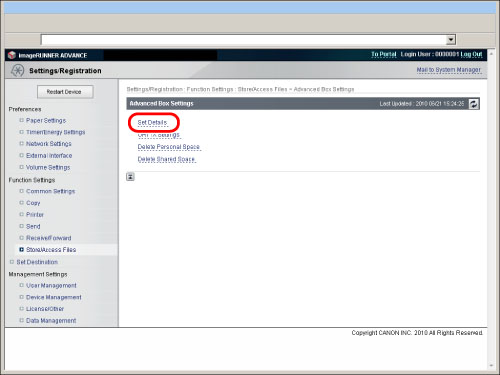
3.
Specify the desired settings → click [OK].
|
Open to Public:
|
Set whether to open the Advanced Space of the machine externally as a WebDAV server or SMB server on the network.
|
|
WebDAV Server Settings:
Authentication Type:
|
Select [Basic] to set the Advanced Space to be open externally as a WebDAV server and use authentication management.
|
|
Use SSL:
|
Select this to use SSL encrypted communications.
|
|
Allow to Create Personal Space:
|
Set whether to allow personal spaces to be created in the Advanced Space.
|
|
Prohibit Writing from External:
|
For users that accessed the machine via a computer or other machine, you can set whether to prohibit that user from creating a folder or storing a file in the Advanced Space that was opened externally.
|
|
Authentication Management:
|
Set whether to perform authentication management for the users that access the Advanced Space.
|
|
File Formats Allowed for Storing:
|
You can set the file formats allowed for storing in the Advanced Space.
If you select [Device Supported Formats], you can store files in the pdf, jpg, jpe, jpeg, tif, tiff, xps, or pptx format.
If you select [Common Office Formats], you can store files in the doc, docm, rtf, xls, xlsx, xlsm, csv, ppt, pptm, txt, iwd, iwt, iws, lnk, tmp, iwb, iwbt, iwc, iwl, iwu, iwn, iwx, grb, seq, ini format, or files without extension, in addition to the file formats for [Device Supported Formats].
If you select [All], there are no restrictions on the file formats for storing in the Advanced Space. In addition to the file formats for [Device Supported Formats] and [Common Office Formats], you can store files in various formats.
|
|
IMPORTANT
|
|
If the imagePASS is attached to the machine, you cannot open the Advanced Space of the machine externally as an SMB server. Set to open as a WebDAV server on the network.
|
Specifying the URI TX Settings
You can use the URI TX Settings mode to notify a user via e-mail that a file has been saved in the Advanced Space of the machine. The notification e-mail contains the path (URI: Uniform Resource Identifier) to the folder that includes the file.
1.
Click [Settings/Registration] → select [Store/Access Files] for <Function Settings>.
2.
Click [Advanced Box Settings] → [URI TX Settings].
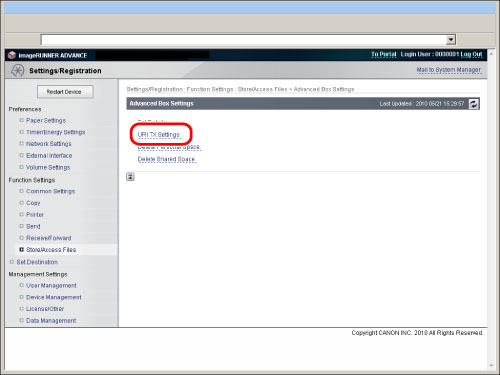
3.
Click [Register New...].
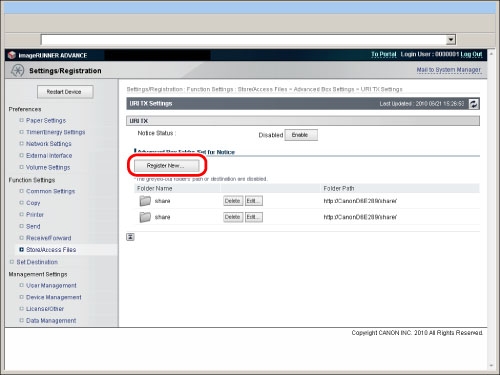
4.
Enter the path of the folder to notify.
When the Advanced Space is opened externally as an SMB server:
Enter the IP address or host name of the machine plus "\share" or "\users", followed by "\folder_name".
Example:
\\192.168.1.21\share\documents (to specify the [documents] folder in the Shared Space)
\\192.168.1.21\users\suzuki (to specify the [suzuki] folder in the Personal Space)
When the Advanced Space is opened externally as a WebDAV server:
Enter the URL in the format "http(s)://<IP address or host name of the machine>\<share or users>\<folder name>".
Example:
http://192.168.1.21/share/documents (to specify the [documents] folder in the Shared Space, when SSL is disabled)
https://192.168.1.21/users/suzuki (to specify the [suzuki] folder in the Personal Space, when SSL is enabled)
If the imagePASS is attached to the machine, it is necessary to specify the port number (when SSL is disabled: 18080, when SSL is enabled: 18443).
Example:
http://192.168.1.21:18080/share/documents (to specify the [documents] folder in the Shared Space, when SSL is disabled)
5.
Select the timing for sending the URI TX.
|
When specified as a store location in Scan and Store:
|
Notification is sent each time a file is saved in the specified folder inside the Advanced Space from [Scan and Store] on the touch panel display. However, notification is not sent when a file is saved in or a folder is added to a subfolder.
|
|
When a loopback address has been specified to send or forward:
|
Notification is sent each time a file is saved in the specified folder inside the Advanced Space from a loopback address (an address that indicates the same device on a network) using the Send or forwarding function. However, notification is not sent when a file is saved in or a folder is added to a subfolder. Specify a loopback address when using the Advanced Space of the machine as the destination for [Scan and Send] or [Forwarding Settings]. (See "Registering an Advanced Space Address.")
|
|
When the total of documents and sub-folders in the folder reaches 700:
|
Notification is sent when the total number of files and subfolders in the folder specified for notification in step 4 reaches 700. Files and folders inside subfolders are not counted.
|
|
When the total of documents and sub-folders in the folder reaches 900:
|
Notification is sent when the total number of files and subfolders in the folder specified for notification in step 4 reaches 900. Files and folders inside subfolders are not counted.
|
|
NOTE
|
|
You can save a maximum of 1,000 files or sub-folders inside the specified folder.
|
6.
Click [Select Destination] → select the destination → click [OK].
|
NOTE
|
|
You can set a single e-mail address registered in the address book or a single e-mail address group as the destination to notify.
|
7.
Enter the subject for the URI TX.
You can enter up to 40 characters for the subject.
8.
Enter the message for the URI TX.
You can enter up to 140 characters for the message.
|
NOTE
|
|
In addition to the text entered here, the path to the folder specified in step 4 and the file name are also added to the e-mail message.
|
9.
Click [OK].
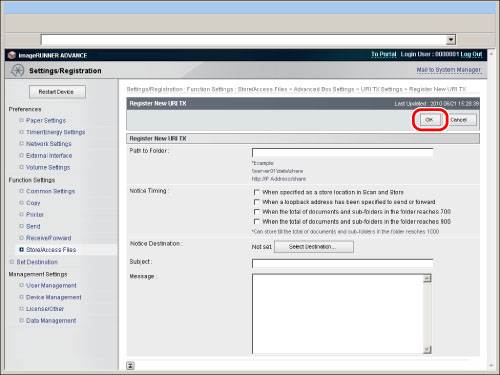
Specifying the URI TX settings is complete.
10.
Click [Enable].
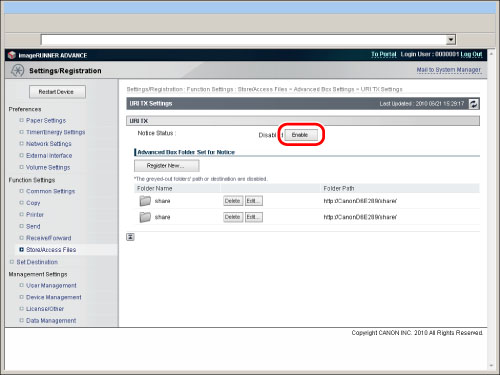
The notification status changes to <Enabled>, and all the registered URI TX Settings are enabled.
If you want to disable the URI TX settings, click [Disable].
To delete a registered URI TX setting:
Click [Delete] for the folder you want to delete.
To edit a registered URI TX setting:
Click [Edit...] for the folder you want to edit.
Deleting Personal Spaces
You can delete one or all the personal spaces inside the Advanced Space.
|
NOTE
|
|
You can only delete single personal spaces from the Remote UI.
|
1.
Click [Settings/Registration] → select [Store/Access Files] for <Function Settings>.
2.
Click [Advanced Box Settings] → [Delete Personal Space].
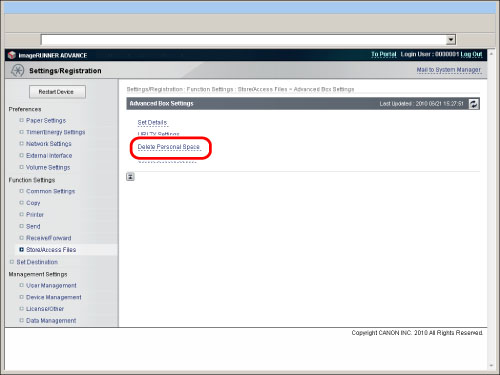
3.
Delete the personal space(s).
To delete a single personal space:
Select the personal space to delete → click [Delete].
To delete all the personal spaces:
Click [Delete All].
Deleting Folders in the Shared Space
You can delete one or all the folders in the Shared Space of the Advanced Space.
|
NOTE
|
|
You can only delete single folders in the Shared Space from the Remote UI.
|
1.
Click [Settings/Registration] → select [Store/Access Files] for <Function Settings>.
2.
Click [Advanced Box Settings] → [Delete Shared Space].
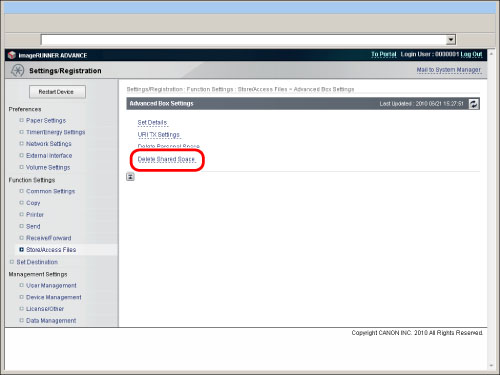
3.
Delete the folder(s) in the Shared Space.
To delete a single folder:
Select the folder in the Shared Space to delete → click [Delete].
To delete all the folders:
Click [Delete All].